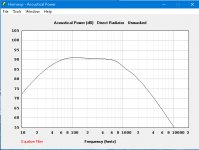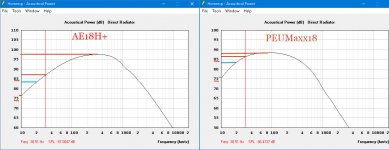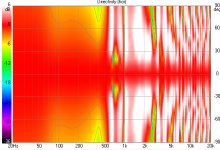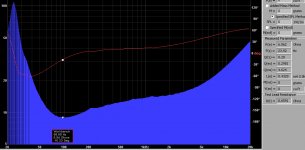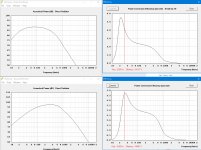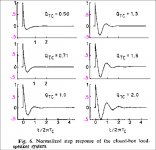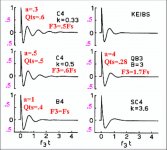The Ae18H+ is in fact a subwoofer...and a midbass combined into one...Or John is lying...hmmmm
The 18H+ is as efficient/sensitive as the Ultimax anywhere in its passband.... hmmm
The 18H+ is more accurate as a subwoofer than the Ultimax due to lower Q and lower Inductance.
Judging a sub by Fs is old fashion/outdated according to John.....
Since he designs some of the best woofers in the world I'm gonna go with his advice lol!
In his words "Fs is only the free air compliance. Once put in the enclosure, the compliance of the system is determined almost completely by the air spring in the enclosure....the suspension of the woofer has almost no effect"
So a vented cab is governed by its tuning and sealed cab is limited by its excursion
A lower system Q always results in higher sound quality, in particular lower than 0.5 for the bass because the room is going to loosen things back up (Learned that from GM)
Whatever box you want to put an Ultimax in.....you can put the 18h+ in....achieve the same efficiency....but have less time distortion due to the lower system Q in the same box size
You don't have to get the apollo version for this description to still hold true...
Its not my fault the best subwoofer that AE offers (the 18h+) also happens to perform just as well in the mid range......
If you go ask him what's his Flag ship subwoofer....he's going to say the 18h+.....
The first go round the board tried to steer me away from the 18H+ to a td15h.....he cleared up the confusion for me...maybe you guys should shoot him an email
The fact is many people are used to bloated bass (translate that as time distortion on the spectral decay)....thats not what the 18H+ does
So the sloppy action of something with a much heavier mms resulting in distortion in the sub bass might be what you are used too....but its not what I want for my system.
My favorite saying....I explain it to you....but I can't understand it for you lol
The 18H+ is as efficient/sensitive as the Ultimax anywhere in its passband.... hmmm
The 18H+ is more accurate as a subwoofer than the Ultimax due to lower Q and lower Inductance.
Judging a sub by Fs is old fashion/outdated according to John.....
Since he designs some of the best woofers in the world I'm gonna go with his advice lol!
In his words "Fs is only the free air compliance. Once put in the enclosure, the compliance of the system is determined almost completely by the air spring in the enclosure....the suspension of the woofer has almost no effect"
So a vented cab is governed by its tuning and sealed cab is limited by its excursion
A lower system Q always results in higher sound quality, in particular lower than 0.5 for the bass because the room is going to loosen things back up (Learned that from GM)
Whatever box you want to put an Ultimax in.....you can put the 18h+ in....achieve the same efficiency....but have less time distortion due to the lower system Q in the same box size
this looks more like how a good 5" midrange would behave than a typical 18" woofer. All of the copper and aluminum shorting paths in the motor have certainly done their jobs. The Fs came in quite a bit lower than the 29Hz factory spec at 18.5Hz, which is unusually low for a driver with such a light Mms and a more pro audio oriented background application. Some of that is due to the slightly higher Mms, but the suspension is also much more compliant than the factory spec. This results in the Qts being very low indeed. The driver build quality is excellent and it certainly gives off a high quality and well engineered vibe. Subjectively it is a very good sounding woofer with a better than average low mid and midrange when compared to most similar sized drivers. It has plenty of displacement to dish out substantial amounts of low bass as well.
You don't have to get the apollo version for this description to still hold true...
Its not my fault the best subwoofer that AE offers (the 18h+) also happens to perform just as well in the mid range......
If you go ask him what's his Flag ship subwoofer....he's going to say the 18h+.....
The first go round the board tried to steer me away from the 18H+ to a td15h.....he cleared up the confusion for me...maybe you guys should shoot him an email
The fact is many people are used to bloated bass (translate that as time distortion on the spectral decay)....thats not what the 18H+ does
So the sloppy action of something with a much heavier mms resulting in distortion in the sub bass might be what you are used too....but its not what I want for my system.
My favorite saying....I explain it to you....but I can't understand it for you lol
Last edited:
When looking at the the first graph where the box has been made a mute point....the true victor stands out....lower Q, lower inductance, lower mass driver, and higher efficiency win. The win for the Ultimax is Higher Xmax....for mycase....something that will never be encroached upon
Who ever designed the 18h+ is a genius in short.
I can't see your 300+L graph of the 18+ either, so here's a comparison I made.
On left is 49L, qtc 0.7, 102v, 14mm excursion at 20Hz.
On right is 315L, qtc 0,35, 40v, 14mm excursion at 20Hz.
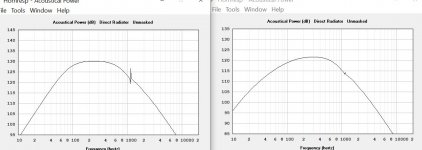
All that happens with the box volume increase is a reduction in the 18+'s ability to make the huge SPL it's capable of in the middle of its range.
The low corner, again choosing 20Hz, stays unchanged. The driver has been "dumbed down" like GM said.
There is no box size or EQ that can take the 18+ above 105dB at 20Hz, without exceeding xmax.
The Ultimax is good for 110dB at 20Hz at xmax. The 18+ can not do that period. 5dB at 20Hz is a huge difference.
In my book, you are taking a very fine woofer, and sub-optimizing it into a subwoofer.
Why you can't see that is very puzzling. Speculation about why the 18+ has sonic superiority seems equally strange.
It appears like there is a need to justify the choice of the 18+.....
It's still about displacement a vented sub just has hardly any displacement capability below that point and needs a high pass filter to protect it if played loud.
I was talking about excursion above vent tuning, not below.
I should have just said excursion is minimum at vent tuning frequency and then rises as frequency increases.
Which shows SPL isn't simply about displacement.
Like in this 18FH500 vented.
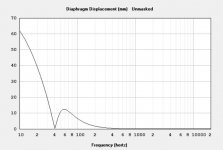
little bit of eq....
matching box volume should be about 326l
This is true...gotta add more woofers...my point is that what it does...within reasonable excursion, is better than what the Ultimax does at matching volume. PeriodThere is no box size or EQ that can take the 18+ above 105dB at 20Hz, without exceeding xmax.
How much spl does one need at 20hz....isn't there huge room gain here?
So max dynamic ability still owns SQ down this low where I thought 2order distortion isn't an issue?The Ultimax is good for 110dB at 20Hz at xmax. The 18+ can not do that period. 5dB at 20Hz is a huge difference.
Does this prove nothing? Once again this is two exact box sizes....and basically matching sensitivities through range under inspection... One looks to have a longer tail than the other...how is that... better...
its a slopfest through 40hz in comparison...
Ps- free air resonance of my 18H+ is 23.5hz
Attachments
Last edited:
Fs is 24 (not 23.5)still lower than the Ultimax (27),.....ok so the ultimax plays 20hz louder than the 18h+....what use is that? Is this a matter of max spl @20hz? My sub is going to play to ~70-100hz what about 30hz on up...where the 18H+ does everything better.... how is that not win?the AE TD18H+-4 Apollo version actually has a lower peak than the Ultimax. Might call that one a true sub?
implementing active radiator technology to increase output....this is what I ended up with
is it improper to go past Xmax at 20hz? within Xlim was 115db at 20hz
ps- you guys know I argue hard...don't think I am not taking in what you are saying =P
Attachments
Last edited:
Hello camplo
So you are running the 18 up to your horn and crossing at about 300/350Hz??
Rob 🙂
So you are running the 18 up to your horn and crossing at about 300/350Hz??
Rob 🙂
Hi, There is a sharing of bandwidth with a 15m....I've always modelled the 15 with a 12db/oct hp at 47 and similar XO point and slope for the low pass on the 18"s....lol I was just about to remove the high pass on the 15 to see what efficiency gains might be had....and I noticed somehow how I've created directivity on the horizontal polar down to 100hz..albeit slight....if that holds water, it would be a happy mistake lol.
The LP on the 18"s doesn't tell the whole story because of the high sensitivity in the midrange of the of the 18H+'s...I play with the lp to bring the affecting passband just under the XO at 400hz...wait thats not true...its sorta true...I have it adjust right now so the 18's are down -25db at 232hz..I haven't figured out if I can crossover lower (horn vs 15m) since my last schooling on eq/voicing
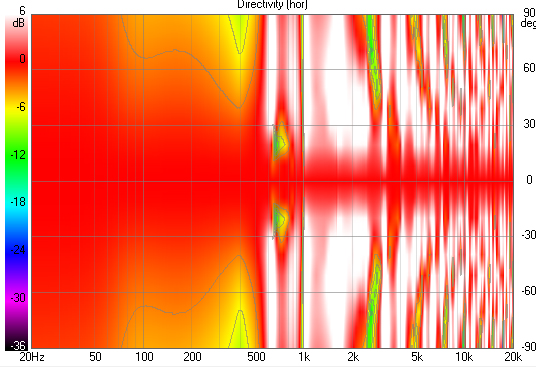
The LP on the 18"s doesn't tell the whole story because of the high sensitivity in the midrange of the of the 18H+'s...I play with the lp to bring the affecting passband just under the XO at 400hz...wait thats not true...its sorta true...I have it adjust right now so the 18's are down -25db at 232hz..I haven't figured out if I can crossover lower (horn vs 15m) since my last schooling on eq/voicing
Attachments
Last edited:
So my non-subwoofer has a lower Fs than the Ultimax18....do tell...hahahahaha
Attachments
Last edited:
Camplo, Why do you seem so hung up on the Ultimax vs TD18? You have 4 TD18 and are planning to use them yes? Are you considering changing to Ultimax? IMO you should be focusing on how to get the best out of those TD18. Also IMO, putting them under your two way is probably doing it wrong. Have you considered deploying them in a distributed array ala Geddes?
Multiple Small Subs - Geddes Approach
Multiple Small Subs - Geddes Approach
I just like debating drivers with these guys...they sharpen my knowledge...The Ultimax18 is a reference house hold name subwoofer is all...and for the debate, it being a "traditional" high MMS subwoofer its perfect for the comparison.
If I do a bass array why can't the front subs live under the mains? For this design I wanted to keep all sources as close together as possible... I had plans on adding 2 more sub units to create the bass array but I've read from a couple of mastering engineers (Bob Kats) that they preferred the stereo subs so we'll see.
If I do a bass array why can't the front subs live under the mains? For this design I wanted to keep all sources as close together as possible... I had plans on adding 2 more sub units to create the bass array but I've read from a couple of mastering engineers (Bob Kats) that they preferred the stereo subs so we'll see.
Dr. Geddes is several leagues more competent than me to answer, but the 'long and short of it' IME WRT driver specs, construction, sonic comparisons; I've periodically posted that it comes down to pace, rhythm & timing [PRaT], so the lower and/or the narrower the BW, the less likely we can hear any differences'
Being as relating perception to math has been my life's work, I'll comment, although many won't like what I have to say.
For a sub, in practice, there is going to be little to no relationship between perception and metrics (T/S etc.)
First there is the fact that our ears are not very sensitive at LFs, i.e. there "resolution" is very low.
Next there is the fact that in practice the room will totally dominate all perceptions at LFs and the T/S values will have little to no relationship to preference - at least in the linear domain. This means that linear volume displacement is just about the only real value that matters. This can be achieved by one driver or many, it makes no difference linearity wise. With many however we can distribute them and yield a much smoother in room response - which is highly audible - than a single sub placement can yield.
Hence, to me, all this talk of T/S etc. when related to a sub just doesn't matter because it is the end result in the room that matters and this can be achieved with virtually any T/S parameters. The end result will be more dependent on the number and location of the subs than any T/S parameter, driver size, cone mass, box, size, alignment or whatever.
Dammit I just seen the actual Fs of Ultimax.....lmao!!!!
Good because I am not winning them over with spec arguments lol!!! Maybe with the Spectral Decay and the higher bass notes... I agree that the room matters....but what about what you feed the room...it made sense to me that if one had a lower Qtc that the final Q at the ear would be tighter as well.
Hence, to me, all this talk of T/S etc. when related to a sub just doesn't matter because it is the end result in the room that matters and this can be achieved with virtually any T/S parameters.
Good because I am not winning them over with spec arguments lol!!! Maybe with the Spectral Decay and the higher bass notes... I agree that the room matters....but what about what you feed the room...it made sense to me that if one had a lower Qtc that the final Q at the ear would be tighter as well.
Last edited:
I just like debating drivers with these guys...
Funny! ... as you're the only one who seems to think there's anything debatable 😉
So if I am allowed to stop looking at T/S specs then all of our debating previous is sorta null and void.
Compliance and the Spectral Decay are related are they not?
The room has a spectral decay character no less than the loudspeaker system...same goes for compliance
What I think is that compliance starts at the woofer...then is augmented by the box....and the finally by the room...the same may be true for spectral decay...
Each is a derivative of the Q or Spectral Decay upstream in the system....
The better the the compliance of the driver....the better the potential of good compliance of the loudspeaker plus box....the better the potential of the room compliance
And then the same pattern for Spectral Decay..... Compliance and spectral decay seem to go together sort of like Sensitivity and Efficiency.
Linearity, we all understand.....
Ive been trying to sell this idea that within XMAX....The 18H+ is a better subwoofer than the Ultimax18... If Q and spectral decay are the final say so....then there it is. I get that it was said that location and number of subs have a greater effect than which sub but we can mimic each driver in an identical set up and potentially have different sonic results.... If my theory of the chain of spectral decay/Compliance holds water....then I am glad I choose the 18h+....even though the Ultimax18 can play louder at the deepest notes...due to higher XMAX (not efficiency) for my design I am concerned most about 30hz in up.
Compliance and the Spectral Decay are related are they not?
The room has a spectral decay character no less than the loudspeaker system...same goes for compliance
What I think is that compliance starts at the woofer...then is augmented by the box....and the finally by the room...the same may be true for spectral decay...
Each is a derivative of the Q or Spectral Decay upstream in the system....
The better the the compliance of the driver....the better the potential of good compliance of the loudspeaker plus box....the better the potential of the room compliance
And then the same pattern for Spectral Decay..... Compliance and spectral decay seem to go together sort of like Sensitivity and Efficiency.
Linearity, we all understand.....
Ive been trying to sell this idea that within XMAX....The 18H+ is a better subwoofer than the Ultimax18... If Q and spectral decay are the final say so....then there it is. I get that it was said that location and number of subs have a greater effect than which sub but we can mimic each driver in an identical set up and potentially have different sonic results.... If my theory of the chain of spectral decay/Compliance holds water....then I am glad I choose the 18h+....even though the Ultimax18 can play louder at the deepest notes...due to higher XMAX (not efficiency) for my design I am concerned most about 30hz in up.
How about this debate.....
Thats kinda like a fully stuffed vs aim for highest efficiency at all cost type of thing.
My guess is that at home levels...heat is never an issue....I think someone here said that before. Stuffing a box fully does what? Slightly Lowers Q and lowers Spectral decay by a large margin.
Mark100
I was the one to talk about Q and Spectral Decay....Sounds like I was right to me.
The room responds to the spectral decay character of the loudspeaker and the Q. Making the the 18H+ the better subwoofer within XMAX lol!
I added more drivers to lower excursion to keep the Higher SQ (lower Compliance and better spectral decay) of the 18H+ and relieve linear excursion
The 18H+ is cleaner than the Ultimax...lets even say the Ultimax wins at the bottom....18h+ wins anywhere else...a subwoofers duty is not just below 30hz...For THX it starts 120hz even....
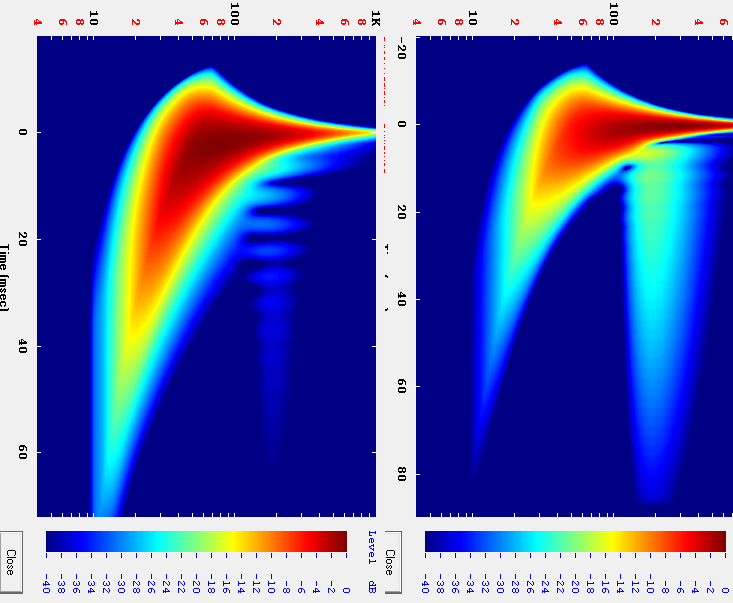
I didnt fully stuff the boxes so there's some resonance left on each that dampening could of killed.
The more I look at this graph....IF I am right about the last statement...its only barely and I wonder if anyone would notice in the room...probably not lol!!! In my defense (someone help me lol!) the efficiency of the 18H+ is higher from 40hz on up so that IS a win =P... and and the power conversion efficiency has to be a good thing!
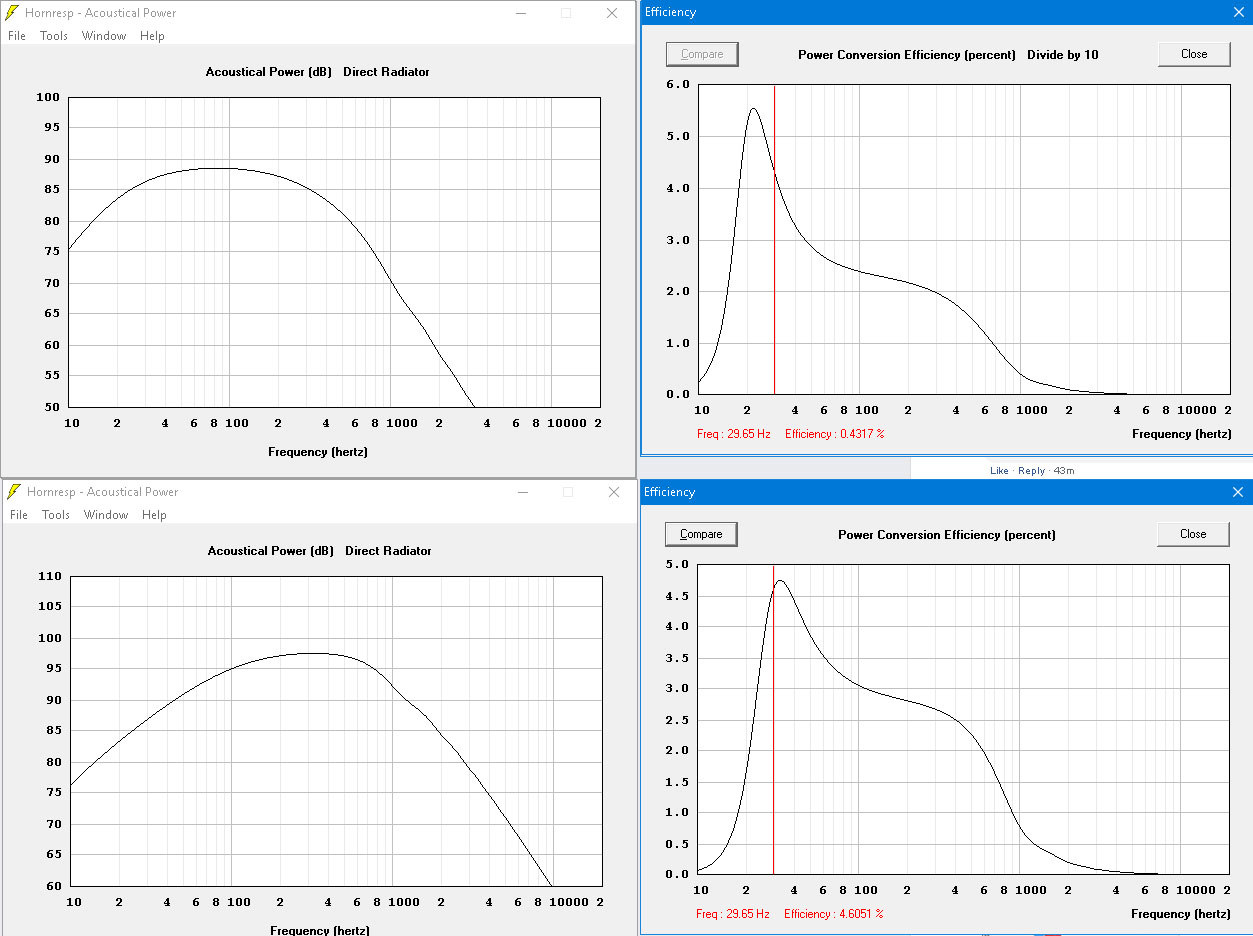
"The impedance peak at Fc...it is actually the area where the driver is most efficient and requires the least amount of current. From a power standpoint and associated thermal distortions, higher peak is better. I understand why people want to damp the peak out. But as you do that, you are losing output over a wider range. Now you need more and more power and more and more heat to get the same output levels. You are trading one issue for another..."
Thats kinda like a fully stuffed vs aim for highest efficiency at all cost type of thing.
My guess is that at home levels...heat is never an issue....I think someone here said that before. Stuffing a box fully does what? Slightly Lowers Q and lowers Spectral decay by a large margin.
Mark100
Funny! ... as you're the only one who seems to think there's anything debatable
For a sub, in practice, there is going to be little to no relationship between perception and metrics (T/S etc.)
I was the one to talk about Q and Spectral Decay....Sounds like I was right to me.
Next there is the fact that in practice the room will totally dominate all perceptions at LFs and the T/S values will have little to no relationship to preference
The room responds to the spectral decay character of the loudspeaker and the Q. Making the the 18H+ the better subwoofer within XMAX lol!
This means that linear volume displacement is just about the only real value that matters. This can be achieved by one driver or many, it makes no difference linearity wise
I added more drivers to lower excursion to keep the Higher SQ (lower Compliance and better spectral decay) of the 18H+ and relieve linear excursion
The 18H+ is cleaner than the Ultimax...lets even say the Ultimax wins at the bottom....18h+ wins anywhere else...a subwoofers duty is not just below 30hz...For THX it starts 120hz even....
I didnt fully stuff the boxes so there's some resonance left on each that dampening could of killed.
The more I look at this graph....IF I am right about the last statement...its only barely and I wonder if anyone would notice in the room...probably not lol!!! In my defense (someone help me lol!) the efficiency of the 18H+ is higher from 40hz on up so that IS a win =P... and and the power conversion efficiency has to be a good thing!
Attachments
Last edited:
I dunno...I look at the power conversion efficiency chart and I think...yep, you made the right choice. I've kept everything linear....Q is overly tight in the right area...helping out where Q is loose (the room)....I made the right choice for me at least. Plus I got this weird extra directivity thing going on with 100hz cause of polarity and probably the shape of the slot vs dispersion from the 15m....
Last edited:
I agree that the room matters....but what about what you feed the room...it made sense to me that if one had a lower Qtc that the final Q at the ear would be tighter as well.
The room more than "matters" it is dominate. And and a lower Qtc will have no perceptual effect at all in a well setup LF room layout.
Sounds like I was right to me.
Everyone believes that - of themselves.
The "Q" of the room modes matters a lot!, but the source, not at all.
Everyone believes that - of themselves.
The "Q" of the room modes matters a lot!, but the source, not at all.
So we are focusing on below the part of the frequency response that is owned by the room.....Q of the source is not an important factor....Surely spectral decay is? Otherwise it sounds like I might as well just remove all the stuffing from the subwoofer and vent it for max efficiency...or build a tapped horn subwoofer. Q of the source matters for midrange (above room modes) at least does it not? Or is everyone going on about this critical Q to no avail?
Attachments
Last edited:
- Home
- Loudspeakers
- Multi-Way
- Is it possible to cover the whole spectrum, high SPL, low distortion with a 2-way?
